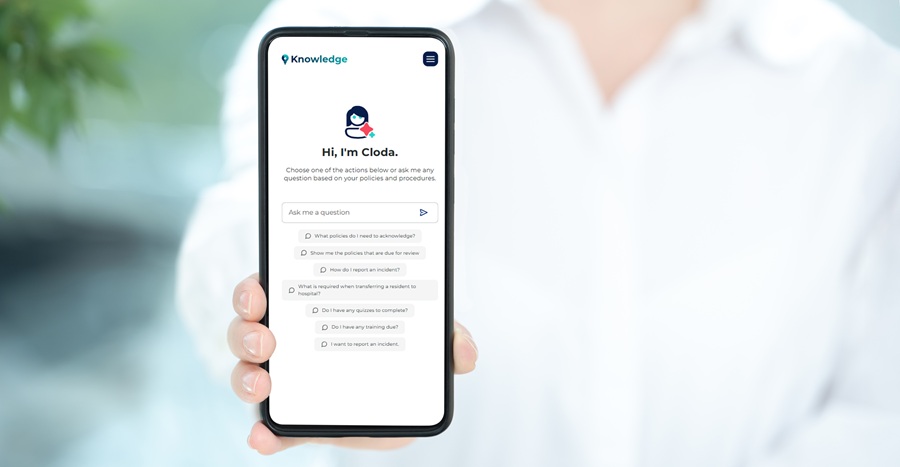
Introduction: The Real Value of User Adoption in Healthcare Technology
Healthcare organisations face increasing pressure to streamline operations, maintain compliance, and improve patient outcomes, despite constrained resources and evolving regulations. Digital transformation isn’t optional; it’s essential. Yet technology alone doesn’t drive success, it’s the people who use it every day who do.
Through our work with hospitals, nursing homes, mental health services, home support, and other care settings across Ireland and internationally, we’ve seen that user adoption is the make-or-break factor. In this article, we’ll explore why user adoption is central to healthcare technology success, common challenges in achieving it, and how Cloda overcomes these barriers to foster safer, smarter care.
Before we dive in, we would love to hear your thoughts below!
Poll: What is the biggest challenge your organisation faces in getting staff to adopt new digital systems?
Cast your vote and see what your peers say!
The Critical Role of User Adoption in Healthcare Technology
Beyond Implementation: Why Adoption Drives Value
Healthcare organisations invest significant resources in digital systems for automation, compliance, and patient safety. However, research shows that where IT projects fail to deliver expected outcomes, poor user adoption is a leading cause. Why? Because no matter how advanced a system is, its value is only realised when staff integrate it into their daily workflows.
Key Takeaways:
- Adoption = ROI: The true return on investment comes from widespread, consistent use – not just from having the system in place.
- Compliance and Safety: Regulatory compliance and best practice adherence depend on staff engaging with policies and procedures in real time.
- Organisational Culture: High adoption rates foster a culture of accountability, transparency, and continuous improvement.
The Human Factor: Technology as an Enabler, Not a Barrier
Healthcare is fundamentally about people – patients, clinicians, and support staff. Technology should empower, not hinder, their ability to deliver care. When adoption is high, digital systems become invisible enablers, supporting staff to “do the right thing” effortlessly. When adoption is low, systems become obstacles, creating frustration and risk.
The Challenges of Driving User Adoption in Healthcare
Resistance to Change
One of the most common barriers is resistance to change. Healthcare professionals are highly skilled and often operate under significant pressure. Introducing new technology can disrupt established routines and create anxiety about increased workload, job security, or loss of autonomy.
Common Concerns:
- “Will this add to my workload?”
- “How much time will training take?”
- “Will I lose control over my work?”
Time Constraints and Workload Pressures
Frontline healthcare staff juggle competing priorities. They are expected to deliver high-quality care, manage administrative tasks, and stay up to date with evolving protocols. Time is a precious commodity, and any system that adds complexity or lengthens tasks risks being sidelined.
Implications:
- Training sessions are often poorly attended or rushed.
- Staff default to old habits if new systems are perceived as cumbersome.
- Critical information can be missed, impacting compliance and patient safety.
Complexity and Usability Issues
IT systems have a reputation for being complex and unintuitive. Poorly designed interfaces, confusing navigation, and lack of integration with existing workflows can quickly erode enthusiasm.
Examples:
- Systems that require multiple logins or steps to access information.
- Policies buried in dense documents with limited search functionality.
- Lack of mobile access for staff on the move.
Information Overload
Healthcare organisations generate vast amounts of information – policies, procedures, guidelines, and alerts. Without effective systems for managing and presenting this content, staff can become overwhelmed, leading to disengagement and errors.
Risks:
- Important updates are missed.
- Outdated documents remain in circulation.
- Staff are unsure which procedures to follow.
How Cloda Drives Adoption – Simply and Effectively
Designed for the Realities of Healthcare
Cloda was created with direct input from professionals who understand the realities of busy, health and social care environments. Cloda’s core design principles are simplicity, accessibility, and intelligence.
How Cloda Stands Out:
- Instant Answers: Cloda uses intelligent analysis to provide clear, concise answers to procedures questions in seconds.
- Mobile-Enhanced Access: Staff can access care process information on any device, at the point of care.
- Supports Staff Understanding of Procedures: Cloda’s comprehension quizzes turn passive document acknowledgements into real learning opportunities, ensuring staff truly understand a policy before they acknowledge it.
- Seamless Integration: Fits naturally into existing workflows, reducing friction and resistance.
Real-Time Data Insights for Managers
One of the biggest frustrations for quality managers is lack of visibility into who has read and understood critical documents. Cloda addresses this with robust tracking and reporting features.
What Managers Can See:
- Document acknowledgements by individual and department.
- Quiz completion rates to understand staff comprehension of procedures.
- Policy review workloads.
This data enables targeted follow-up, supports regulatory audits, and demonstrates a proactive approach to compliance.
Making Compliance and Best Practice the Path of Least Resistance
Ultimately, Cloda makes it easier for staff to do the right thing. By removing barriers to accessing procedures, simplifying information, and providing instant support, Cloda helps care providers embed best practice into everyday routines.
Key Outcomes:
- Improved patient safety and quality of care.
- Reduced risk of non-compliance.
- Greater staff confidence and satisfaction.
Real-World Impact Client Success Stories
Case Study: Transforming Access to Care Processes in a Busy Social Care Service
Context: A social care organisation struggled to ensure that frontline-staff had consistent access to the correct procedures in a timely manner.
Solution: Cloda was introduced as the digital solution providing staff with the knowledge of all their procedures, on their mobile devices in seconds. Staff could ask Cloda a question, and she would analyse all their procedures to provide an answer instantly.
Results over 6 weeks:
- 83% of staff logged into Cloda and used the system.
- 64% of active users asked Cloda a question.
- 60% of active users had a conversation with Cloda (1+ questions in a session)
- 59% chance of returning to the system if the user asked Cloda a question.
These figures demonstrate high engagement, and the clear value Cloda provides in daily workflows.

Data-Driven Insights — What You Can Measure with Cloda
Key Metrics for Adoption and Impact
With Cloda, organisations can move beyond anecdotal evidence and track real, actionable data:
- Policy Acknowledgement Rates: See who has read and acknowledged a policy, broken down by department or role.
- Comprehension Scores: Track quiz completion workloads to identify knowledge gaps.
- Policy Review: Monitor policy review deadlines to ensure documents are updated within regulatory timeframes.
- Audit Trails: Maintain a comprehensive record for regulatory compliance.
Turning Data into Action
These insights empower leaders to:
- Target training and support where it’s needed most.
- Celebrate high-performing teams and individuals.
- Demonstrate compliance to regulators and stakeholders.
- Continuously improve processes based on real-world usage.
Best Practices for Driving User Adoption in Your Organisation
Prioritizing User-Friendly Design and Easy Access
No matter how robust or feature-rich a compliance or policy management system may be, adoption will stall if staff find it difficult to use or access. Choosing a user-friendly system with seamless access is fundamental to successful implementation and ongoing engagement.
Tips:
- Mobile-Enhanced Access: Choose a system (like Cloda) that allows staff to access information on any device, whether on the ward, in the office, or in the community.
- Intuitive Interface: The system should be easy to navigate, with powerful search functionality. Avoid clutter and technical jargon, focus on clarity and simplicity.
- Single Sign-On (SSO) and Minimal Clicks: Integrate with existing logins where possible and minimise the steps needed to find information. The fewer the barriers, the higher the adoption.
- In-app tours: Use in-app tours to guide new users through how to use the system.
Why This Matters:
When staff find the system easy to use and can access it without hassle, they’re far more likely to engage with policies, complete required actions, and embrace new digital processes. This translates directly into higher compliance, better patient safety, and a stronger return on your technology investment.
Leadership Buy-In and Communication
Change starts at the top. Leaders must champion new systems, communicate their value, and set clear expectations for adoption.
Tips:
- Share the “why” behind the change.
- Highlight benefits for staff and patients.
- Provide regular updates and celebrate milestones.
Training and Ongoing Support
Offer role-specific guidance, onsite demonstrations, and easy access to support.
Tips:
- Provide launch day “drop-in” training sessions for staff to ask questions.
- Provide quick-reference guides and video tutorials.
Recognize and Reward Engagement
Acknowledge staff who embrace new systems and share success stories across the organisation.
Tips:
- Create friendly competitions such as the number of questions asked in Cloda or quiz completions.
- Highlight “champions” in internal communications.
- Solicit feedback to continually refine the system.
- Share feedback with the wider team to encourage use.
The Future of User Adoption in Healthcare IT
As healthcare organisations continue to evolve, the importance of user adoption will only grow. Systems like Cloda are setting a new standard, not just for compliance, but for empowering staff to deliver the best possible care.
Looking Ahead:
- AI-powered solutions will become more widespread.
- Real-time data will drive proactive compliance and quality improvement.
- User-centric design will remain the cornerstone of successful digital transformation.
Conclusion: Empowering Your Team with Cloda
User adoption is not a “nice to have”, it’s the foundation of healthcare technology success. By making it easy for staff to access, understand, and act on critical information, Cloda helps organisations achieve their goals for compliance, quality, and patient safety.
If you’re ready to see how Cloda can transform policy engagement and compliance in your organisation, contact info@knowledge.care or call 01 629 2559.

Book a Demo (1)
"*" indicates required fields
